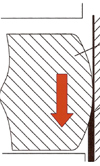Diamond-like-Carbon
 One of the most recent innovations in piston ring technology has been the invention of diamond-like-carbon coatings. The progressive move away from cast or ductile iron towards much stronger but less durable steel designs, made the development of suitable surface coatings a distinct priority.
One of the most recent innovations in piston ring technology has been the invention of diamond-like-carbon coatings. The progressive move away from cast or ductile iron towards much stronger but less durable steel designs, made the development of suitable surface coatings a distinct priority.
Some time ago I had occasion to view the results of a study into engine friction. The engine, a quad-cam V8 of modern design and a ladder frame bottom-end, was motored in the fully hot condition up to 6000 rpm - the limit of the rig. When converted into Mean Effective Pressure the results revealed a total friction of 1.4 bar at 6000 rpm which roughly equates to a figure just over 11% of the total engine output at this speed. Of this, 11% was in the valve train, 21% in the crankshaft and bearings and a whopping 51% in the piston and ring pack. Now bear in mind that this was a fully developed piston and three-ring assembly using suitably coated steel rings and you can begin to see an emerging story here. On a ring-on-block test rig replicating the surfaces and loadings inside a firing cylinder, the coefficient of friction of the standard arrangement was roughly somewhere near 0.3 –0.4. Assuming only half of the friction stated was in the ring pack itself you can begin to see that in using diamond-like-carbon coatings with friction coefficients of less than 0.1, the potential to release valuable horsepower, especially at speeds well in excess of the 6000 rpm tested, is a challenge worth taking.
But what precisely is DLC and how does it differ from that other carbon-based coating, graphite?
To start off with, DLC is the generic name for any number of diamond-like-coatings. Made in two ways, plasma assisted chemical vapour deposition (PACVD) or physical vapour deposition (PVD), diamond-like-coatings are a mixture of sp2 and sp3 bonded carbon atoms of different forms having no dominant crystalline lattice structure. The sp2 and sp3 refers to the position of the electron in the carbon atom, sp2 being that for graphite and sp3 diamond. And while graphite is a soft slippery substance, diamond is the hardest substance known to man. Clearly the more sp3 or diamond in the structure, the harder it will be and the more resistant to wear. However, this will bring with it the disadvantage of higher compressive stresses in the body of the coating (which is around 2-5 microns thick), and in extreme cases, can lead to problems with adhesion and/or delamination of the film.
By introducing so-called ‘fillers’ like the sp2 graphite, hydrogen or other substances (both metals and/or non-metals) other desirable properties can be introduced. Properties like toughness, wear resistance, adhesive properties and coefficient of friction can all be manipulated by altering the deposition regime to give the exact balance of properties deemed necessary. In the case of one particular variety, an a-C:H coating consisting of only carbon and hydrogen and deemed suitable for a piston ring, when run in a dry steel-on-ball test at a load of 10N and a speed of 170 cm/second, ran for over 100,000 cycles before failure. If we were to add in a lubricant, as you might expect as in the case of a piston ring in a cylinder bore, and the dry coefficient of friction which was originally quoted as 0.10, would drop further and failure, if it happened at all, would take much, much longer.
With these characteristics, no wonder everybody is raving about the stuff.
Written by John Coxon.